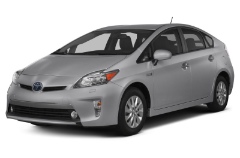This week’s tester was definitely in the family. My drive in the Habanero colored 2014 Toyota Prius C Hybrid was pure jollification. When I walked outside you couldn’t miss the Prius. The Habanero color puts you in the mind of either “Home Depot” or “Lil Caesars” bright orange color. In addition, it also puts you in the mind of a “space car” and its small exterior will definitely fool a person. Once you are in the Prius, it’s like opening a small box with a large gift planted inside. It’s actually kind of cozy inside, and elbow room is sufficient.
For $24,353 if you want to stay cool, park in the sun. The available Solar Roof is embedded with solar panels that can power a fan to circulate ambient air through the cabin when the Prius is parked in direct sunlight. This feature helps keep cabin air temperature close to that of the outside air for a more comfortable return to the vehicle.
The 2013 Toyota Prius C is offered in numbered trim levels from One to Four. The base Prius C One comes with 15-inch steel wheels, automatic climate control, full power accessories, a folding rear seat, a 3.5-inch multifunction display, a tilt-and-telescoping steering wheel, Bluetooth phone and audio streaming and a four-speaker sound system with a CD player and a USB/iPod interface.
The Prius C Two adds cruise control, a height-adjustable driver seat, a center console storage bin and armrest, 60/40-split-folding rear seats, a faux leather dash panel, a cargo cover and a six-speaker sound system. Upgrading to the Prius C Three gets you navigation with a 6.1-inch touchscreen, keyless ignition/entry, satellite radio and voice control. Also included is Toyota’s Entune smartphone integration system that adds Bing search functions, streaming Internet audio and traffic, sports and stock information. Alloy wheels are available as an option.
The range-topping Four adds alloy wheels, heated mirrors, foglights, a faux-leather-wrapped steering wheel and seat upholstery and heated front seats. Options for the Four include 16-inch wheels and quicker-ratio steering. A sunroof is available on both the Three and Four.
The 2013 Toyota Prius C is powered by a similar but smaller hybrid powertrain than its bigger Prius siblings. A 1.5-liter four-cylinder gasoline engine produces 73 horsepower and 82 pound-feet of torque, while a pair of electric motor/generators supplies an additional 60 hp. The gas engine acts as a main propulsion source as well as a generator to charge the nickel-metal hydride batteries. The electric motors also contribute to propulsion and charge the battery pack under deceleration. Combined power output comes to 99 hp and is sent to the front wheels via a continuously variable transmission (CVT).
In Edmunds performance testing, the Prius C needed 11.3 seconds to reach 60 mph, which is quite slow even for a subcompact car.
Of course with any Prius, the most important numbers relate to fuel economy, and the Prius C does not disappoint. EPA-estimated mileage stands at 53 mpg city/46 mpg highway and 50 mpg in combined driving, making it the most economical non-plug-in hybrid on the market. That’s not only a big relief on your pocketbook, but the environment as well.
Prius safety features on all C models include stability control, traction control, antilock brakes (front discs, rear drums), hill start assist, front seat side airbags, side curtain airbags, a driver knee airbag and unique front seat cushion airbags that help prevent occupants from sliding under the seatbelts in the event of a collision. In Edmunds brake testing, a Prius C came to a stop from 60 mph in a better-than-average 118 feet.
The Insurance Institute for Highway Safety awarded the Prius C the highest possible rating of “Good” in the frontal-offset, side-impact and roof strength tests.
Inside, the Prius C features a sleek, modern design with a mix of the familiar as well as the unconventional. Centrally located gauges are mounted high atop the dashboard, which can be a bit odd at first, but makes for easier reading. To its detriment, the cabin’s plastics are several steps below the materials you’ll find in other subcompacts like the Ford Fiesta and Hyundai Accent. The cloth seat upholstery is nothing special, but it’s certainly preferable to the optional “faux leather.”
In terms of comfort, the Prius C presents a mixed bag, particularly for taller passengers. The driving position is slightly compromised by the lack of enough extension for the steering wheel’s telescoping function, and the tall, upright dash can be hard to peer over. The front passenger may also take issue with the glovebox that intrudes into the footwell. Backseat occupants will likely fare better, as there’s ample head- and leg-room for adults, and the fully flat floor allows for even more flexibility.
The base Prius C One’s rear seat folds down as one piece, but Two and above feature a 60/40 split for greater passenger/cargo versatility. With all the seats in use, cargo capacity stands at 17.1 cubic feet, which is about what you’d expect from a hatchback in this class.
Until next week, drive safe, buckle up and please don’t text and drive, it’s the law.




